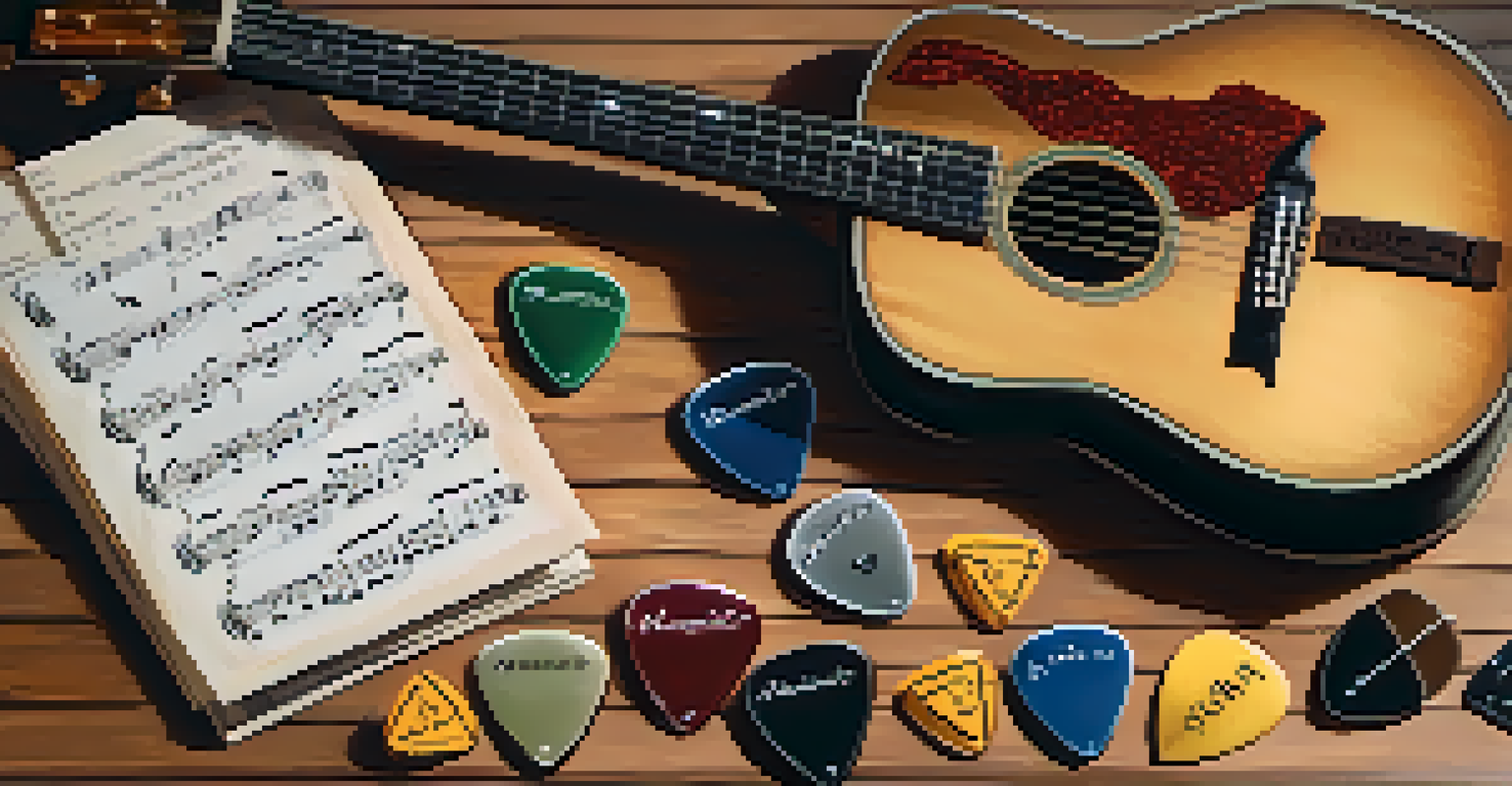Chords and Progressions: Essential Techniques for Guitarists

Understanding Basic Guitar Chords: The Building Blocks
At the heart of guitar playing are chords, which are simply groups of notes played together. For beginners, mastering basic chords like C, G, D, and A is crucial. These chords form the foundation of countless songs across various genres, from pop to rock.
The guitar is a miniature orchestra in itself.
Think of chords as the ingredients in your favorite recipe; without them, you can't create the dish. Once you feel comfortable playing these basic shapes, you'll find that you can quickly learn and play many popular songs. Practicing these chords helps develop finger strength and dexterity, setting you up for more complex progressions.
As you progress, try incorporating different strumming patterns to add rhythm and style. This not only makes your playing more dynamic but also helps your ear develop, allowing you to recognize how chords fit together in songs.
The Magic of Chord Progressions: Creating Music
A chord progression is a sequence of chords played in a specific order, forming the backbone of a song. For instance, the I-IV-V progression (like C-F-G in the key of C) is incredibly common and versatile. Understanding these patterns is essential for any guitarist looking to write their own music or jam with others.

Think of chord progressions as the roadmap for a musical journey; they guide the listener through the highs and lows of a song. By playing around with different progressions, you can evoke various emotions and vibes, whether it's a happy tune or a melancholic ballad. This experimentation is where your creativity flourishes.
Master Basic Chords for Success
Learning essential chords like C, G, D, and A lays the groundwork for playing many popular songs.
Additionally, recognizable progressions, such as the classic I-V-vi-IV (C-G-Am-F), can help you connect with other musicians. Many popular songs utilize these progressions, making it easier to collaborate and perform together.
Exploring Open Chords vs. Barre Chords: What's the Difference?
Open chords are typically easier for beginners and involve using open strings, while barre chords require pressing down multiple strings with one finger. Open chords often sound bright and resonate well, making them perfect for acoustic settings. However, barre chords unlock a new realm of possibilities on the guitar.
Music is the shorthand of emotion.
Imagine open chords as the stepping stones on your guitar journey, while barre chords represent the bridge that allows you to explore further. Barre chords enable you to play in different keys and access a wider range of music, which is essential as you progress. They may seem challenging at first, but with practice, they become a valuable part of your toolkit.
To transition smoothly between these types of chords, practice switching between open and barre chord shapes. This adaptability will not only enhance your playing but also boost your confidence as a guitarist.
The Role of Rhythm: Keeping Your Progressions Alive
Rhythm is just as important as the chords you play; it's the heartbeat of your music. A simple chord progression can sound entirely different based on how you strum or pick the strings. Experimenting with various rhythmic patterns adds depth and personality to your playing.
Think of rhythm as the dance that your chords engage in. It keeps the listener interested and enhances the emotional impact of the music. Whether it's a steady strum or a syncopated picking pattern, rhythm can transform a basic progression into something captivating.
Explore Chord Progressions Creatively
Understanding and experimenting with chord progressions enhances your ability to create and connect musically.
To improve your rhythmic skills, practice with a metronome or play along with your favorite songs. This not only helps you stay in time but also encourages you to explore new ways to express your chords musically.
Integrating Scales: Enhancing Your Chord Progressions
While chords provide the harmony, scales offer the melody, and integrating them can elevate your playing. Understanding how major and minor scales relate to your chords can help you create solos and embellishments that complement the progressions. For instance, if you're playing a C major chord, the C major scale is a natural fit for improvisation.
Imagine scales as the colors on an artist's palette; they allow you to add vibrancy and character to your musical creations. By practicing scales alongside your chord progressions, you'll develop a better understanding of how melodies and harmonies work together.
Additionally, incorporating scale runs between your chords can create smooth transitions and add an engaging dynamic to your performance. This technique not only showcases your skills but also keeps your audience captivated.
Transposing Chord Progressions: Playing in Any Key
Transposing is the process of changing the key of a song, which allows you to play it comfortably within your vocal range or adapt it for different instruments. Understanding how to transpose chord progressions is a vital skill for any guitarist. It empowers you to play along with other musicians without being limited to one specific key.
Think of transposing as shifting gears in a vehicle; it helps you navigate different musical landscapes. For example, if a song is in the key of C but doesn't suit your voice, you can easily move it to D by shifting all the chords up two steps. This flexibility opens up a world of opportunities for collaboration and creativity.
Practice for Chord Skill Development
Regular practice, along with varied exercises, is crucial for mastering chord changes and improving overall guitar skills.
To practice transposing, start with simple chord progressions and gradually work your way to more complex ones. This exercise not only enhances your understanding of music theory but also builds your confidence in playing across various keys.
Practical Tips for Developing Your Chord Skills
Like any skill, practice is key to mastering chords and progressions. Set aside dedicated time each day to focus on chord changes, strumming patterns, and progressions. Start slow, ensuring that each transition feels smooth before increasing your speed.
Incorporating a variety of exercises, such as playing along with backing tracks or jamming with friends, can make practice more enjoyable. This not only keeps your sessions engaging but also allows you to apply what you've learned in a real musical context. Remember, the goal is to have fun while developing your skills!

Additionally, recording yourself can provide valuable feedback. Listening to your progress helps you identify areas for improvement and celebrate your achievements. As you continue to hone your craft, you'll find that your confidence and creativity blossom.